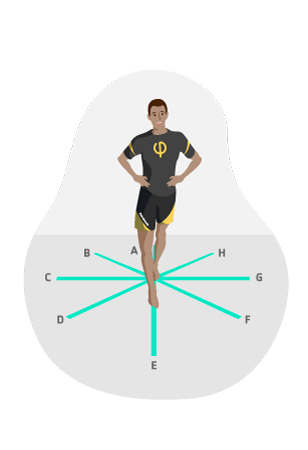
Star excursion balance test (SEBT)
The Star Excursion Balance Test (SEBT) is a widely used test to assess and/or detect deficiencies in dynamic postural control due to asymmetries, decompensations or musculoskeletal injuries, such as instability of the ankle, knee, hip or lack of strength in the core. This test allows to detect individuals at risk of suffering a lower limb injury thanks to its requirements in terms of strength, flexibility and proprioception.
- Required Material: A flat, non-slip surface, a tape measure and 4 strips of adhesive tape of approximately 1.8 and 2.5 metres long. An “8-pointed star” will be drawn on the floor, with lines separated 45° from each other (see illustration).
- Procedure: The subject stands barefoot in the middle of the “8-pointed star”, as shown in the illustration, keeping balance on one leg. With his/her other leg, the subject will try to reach as far as possible with the tip of his/her toes on each of the 8 branches of the star. Then the distances reached will be measured. The anterior, posteromedial and posterolateral directions will be the most important in detecting instability and will indicate an increased risk of injury. The test should be performed on both legs and the results will be analysed.
- Assessment: It is measured in centimetres (cm) and a single result will be registered although it is always advisable to take several measurements to obtain a more reliable value. When the subject shows a large difference between one leg and the other, there is a decompensation.
- Remarks: The SEBT is a widely used test for injury risk prevention. This test has been proposed as a way of analysing muscle symmetry/asymmetry in athletes of different disciplines. Test results have been shown to improve after the prescription of appropriate training.There is a very similar variant of this test, called the Y Balance Test (YBT), also available from Fisicalcoach, which simplifies the work as it has been shown that the posteromedial direction is the most indicative of injury risk.
Take this test and 139 more in our App